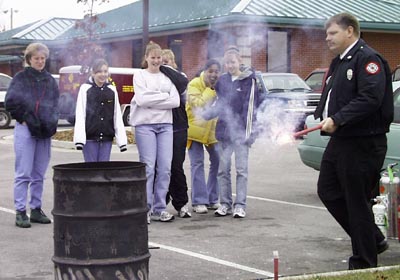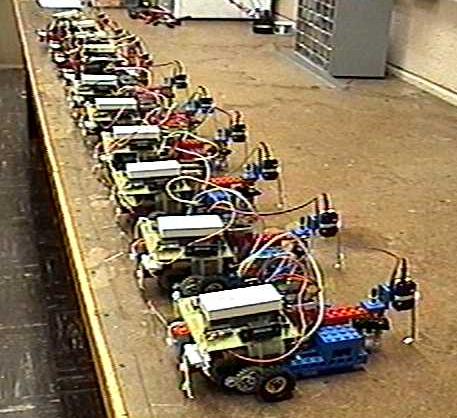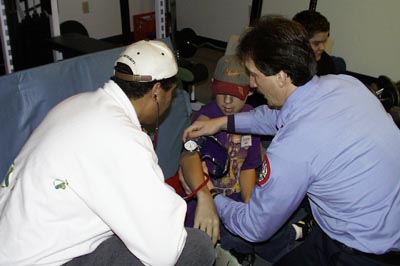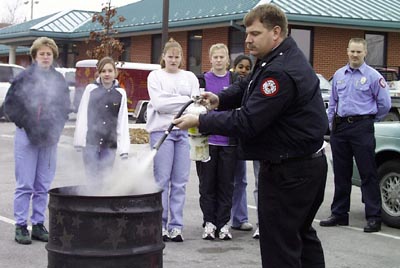

The Saturday Scientist Program is a hands-on, industry based experience designed for junior high school students (grades 8 and 9). The goals of the program are to provide meaningful extra-curricular science experiences for the students and to increase students’ awareness of potential careers in the physical sciences. The pilot program was conducted in the spring of 1998, and the program was further developed in 1999 and 2000. Each local industry sites hosts a total of approximately 100 students from the three Columbia (MO) public junior high schools. Each school rotated through each of the three sites during the pilot. The 3-hour programs are conducted one Saturday each month in February, March, and April.
The Sites…
3M Electronic Products Division, Columbia, MO (1998)
The 3M site in Columbia, Missouri, manufactures flexible circuit boards for use on inkjet printer cartridges. During manufacturing, the circuit boards undergo a developing process, somewhat like photographic film developing. During their Saturday Scientist experience, the students walked step-by-step through the manufacturing process, both on paper and in the plant. They then performed an experiment to determine the effect of certain variables (time, temperature, and agitation) on the developing process. The students were able to see a demonstration of a scanning electron microscope (SEM) and how that instrument is used in improving the 3M manufacturing process. The 3M visit exposed students to a variety of technical careers in chemical manufacturing from process line workers to clean room technicians to research chemists and engineers.
City of Columbia, Water & Light Division, Columbia, MO (1998)
Energy conservation was the focus of the Saturday Scientist experience at the Water & Light site. After a tour of the city’s coal-powered electricity generating plant, the students conducted an insulation experiment. Working in groups of three to five, the students built tabletop houses from various insulating materials, including cardboard, cardboard covered with aluminum foil, foam insulation, drywall, and Plexiglas. A 100-W light bulb heat source was placed in the house and the students took interior and exterior temperature readings every 2 minutes for 12 minutes. After plotting the data, the students estimated the steady-state temperatures to compare the effectiveness of the insulating materials. During the measurement process, the students were able to visually see the thermal leaks in their houses using an infrared camera. After the experimental data collection, the students attempted to further insulate the houses by sealing leaks, applying window treatments and trying other creative ideas.
Industrial Engineering Department, University of Missouri-Columbia (1998)
The Saturday Scientist program at the Industrial Engineering Department was focused on providing an overview of the types of problems that industrial engineers address. The students experienced modeling and simulation activities in queuing using both manual and computer models. They investigated ergonomics by doing learning curve activities, such as drawing a star figure while looking in a mirror and placing playing cards in piles based on different criteria (number, suit, color). Finally, they developed a solution to a complex, open-ended problem using limited materials in a limited time frame. One of the problems given was to construct a structure using only four straws and a sheet of tissue paper that could cushion the fall of a golf ball from a height of 2.5 meters. During the session at the Industrial Engineering Department, the students were briefly exposed to career possibilities and requirements for many different engineering disciplines and provided with opportunities for extended interaction with industrial engineering undergraduate and graduate students and professors.
KOMU-TV (1999)
At the local NBC affiliate students watched the creation of news and weather reports, then got to create their own videos, edit and produce them.
City of Columbia, Water & Light Division, Columbia, MO (1999)
Energy production and usage was the focus of the Saturday Scientist experience at the Water & Light site. After a tour of the city’s coal-powered electricity generating plant, the students conducted an insulation experiment. Working in groups of three to five, the students worked with measuring usage of appliances in tabletop houses. The engineers at the Water and light department had come up with an ingeneous plan to use safe 12V supplies and yet give the appearance of energy use of large appliances like air conditioners, refrigerators, stoves,etc by modifying LED based lights with added resistors. Students then used an energy bike to produce their own electricity in order to power these devices.
Career Center, Columbia Public Schools, in collaboration with 3M (1999)
Students made holograms and worked with optical materials in this segment of Saturday Scientist. The Career center has a collaboration to train optical technicians for 3M, and have a state of the art holography set up. Students saw this rarely recognized field of expertise at this location.
Robotics Lab, University of Missouri-Columbia (2000)
City of Columbia Water and Light Department (2000)
City of Columbia Fire Department (2000)
Robotics Lab, University of Missouri-Columbia (2001)
City of Columbia Water and Light Department (2001)
Career Center, Columbia Public Schools, in collaboration with 3M (2001)
City of Columbia Water and Light Department (2002)
City of Columbia, Fire Department (2002)
School of Veterinary Medicine, University of Missouri-Columbia (2002)
Program developers…
- Meera Chandrasekhar, Professor of Physics, University of Missouri
- Becky Litherland, Science Coordinator, Columbia Public Schools
- Calene Cooper, Science Teacher, West Junior High School
- John Jacob, Science Teacher, West Junior High School
- Marsha Tyson, Science Teacher, Oakland Junior High School
- Nancy Ionatti, Science Teacher, Jefferson Junior High School
- Cathy Dwiek, Science Teacher, Jefferson Junior High School
- Jay Hasheider, Energy Management Specialist, City of Columbia, Water & Light Division
- Tim Pohlman, City of Columbia, Water & Light Division
- Cerry Klein, Associate Professor of Industrial Engineering, Univ. of Missouri-Columbia
- Rebecca Morlando, Senior Analytical Chemist, 3M Electronic Products Division
- Pearl John, Career Center
- Stacy Woeppel, KOMU TV.
- Marge Skubic, Department of Computer Engineering and Computer Science, University of Missouri-Columbia
- Steve Sapp, Fire Chief and Frank Barfield, Assistant Fire Chief, City of Columbia
- Barbra Horell, School of Veterinary Medicine, University of Missouri-Columbia
- Kathy Phillips, University of Missouri-Columbia
- Gordon Prince, University of Missouri-Columbia
- Donna Whitener, University of Missouri-Columbia
- Jennifer Geib, University of Missouri-Columbia
Saturday Scientist has been sponsored by Junior High School science teachers since 2003, and has become part of the school’s standard extra-curricular offerings.
Evaluation instruments used for Saturday Scientist


